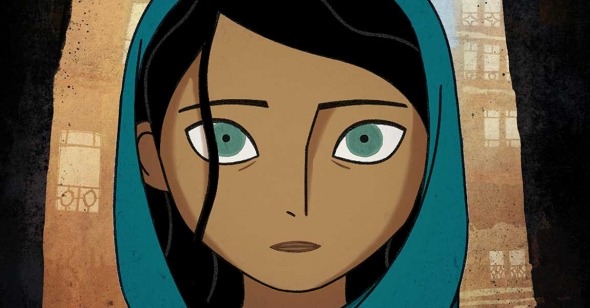
The Breadwinner (2017) and Persepolis (2007) are both animated films that focus on young female protagonists navigating war-torn and politically oppressive environments. Both of the films follow these protagonists (Parvana in The Breadwinner, and Marjane in Persepolis) as they navigate their lives through the oppression, war and societal restrictions (Afghanistan under Taliban rule in The Breadwinner and Iran during and after the Islamic Revolution in Persepolis).

Parvana disguises herself as a boy to support her family under Taliban rule, while Marjane questions and rebels against the restrictions placed on her in post-revolutionary Iran. The Breadwinner uses a mix of hand-drawn animation and stylized storybook sequences, emphasizing folklore and resilience. This is most evident in the scenes where Parvana is telling stories, where a very flat picture-book style is used, and a very similar scene is used in Persepolis, where Marjane’s father is telling a story to her.
The stories stylistically look similar, almost looking like cut-out paper puppets, however where The Breadwinner uses this frame narrative to tell a fictional story, Persepolis uses this frame narrative to tell a true historical story. (about the father of the Shah and how the current government came to be.) Besides the fact that one is in black and white and the other is in color, it is also true that the puppet like characters seemed to be more endearing in The Breadwinner as opposed to Persepolis, partly because in the first mentioned film, you are supposed to be rooting for the character rather than angry at them. However, both are still seen from the child’s point of view.
Sadly, I couldn’t find an Image for the scene that I am talking about in Persepolis- but I found it for The Breadwinner!

Both films tell powerful stories of young girls coming of age in oppressive environments, but The Breadwinner leans more into the struggle for survival and resilience, while Persepolis provides a more reflective and autobiographical take on rebellion, and identity. Their different animation styles and tones serve their narratives well, making them compelling yet distinct in their impact.
Sources
https://www.google.com/url?sa=i&url=https%3A%2F%2Fwww.okcmoa.com%2Fvisit%2Fevents%2Fthe-breadwinner%2F&psig=AOvVaw1aIKUBfP06egHQJyBMzawg&ust=1741729954929000&source=images&cd=vfe&opi=89978449&ved=0CBcQjhxqFwoTCODymuy_gIwDFQAAAAAdAAAAABBK
https://www.google.com/url?sa=i&url=https%3A%2F%2Fwww.nytimes.com%2F2017%2F11%2F16%2Fmovies%2Fthe-breadwinner-review.html&psig=AOvVaw1aIKUBfP06egHQJyBMzawg&ust=1741729954929000&source=images&cd=vfe&opi=89978449&ved=0CBcQjhxqFwoTCODymuy_gIwDFQAAAAAdAAAAABBa
https://www.google.com/url?sa=i&url=https%3A%2F%2Fwww.nytimes.com%2F2007%2F12%2F25%2Fmovies%2F25pers.html&psig=AOvVaw03-G8aac74Oe5xZZhKzZSQ&ust=1741731179890000&source=images&cd=vfe&opi=89978449&ved=0CBcQjhxqFwoTCIDeyrfEgIwDFQAAAAAdAAAAABAJ
https://www.google.com/url?sa=i&url=https%3A%2F%2Fen.wikipedia.org%2Fwiki%2FPersepolis_%2528film%2529&psig=AOvVaw03-G8aac74Oe5xZZhKzZSQ&ust=1741731179890000&source=images&cd=vfe&opi=89978449&ved=0CBQQjRxqFwoTCIDeyrfEgIwDFQAAAAAdAAAAABAR